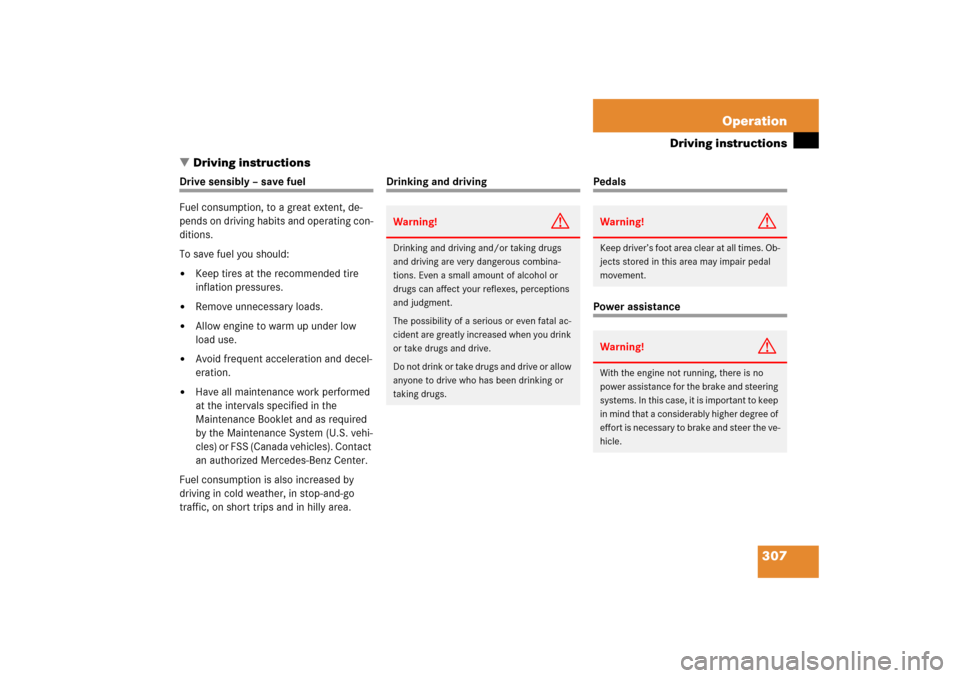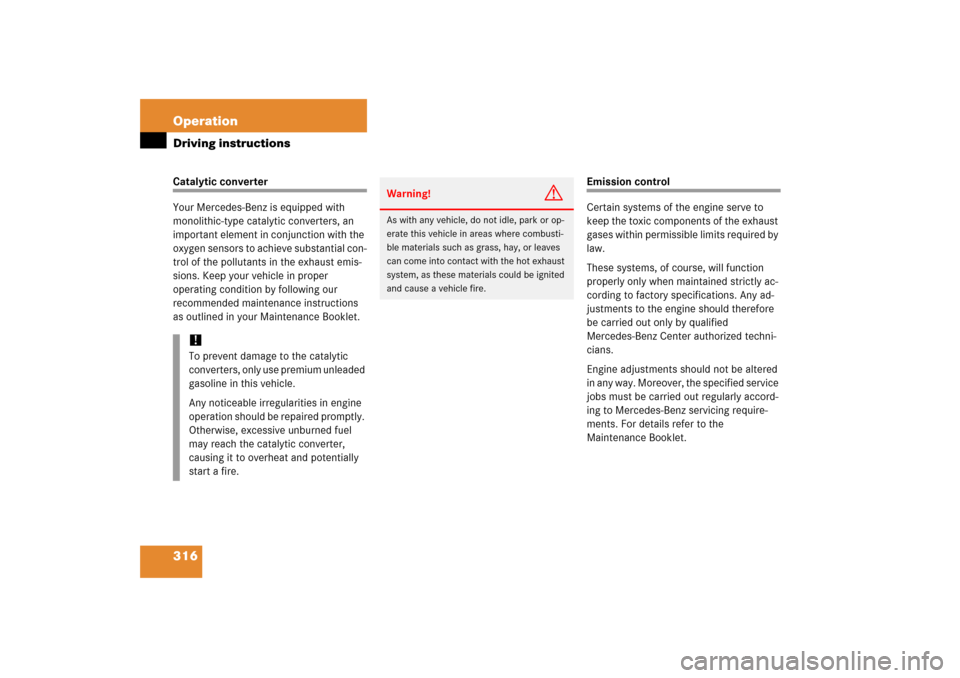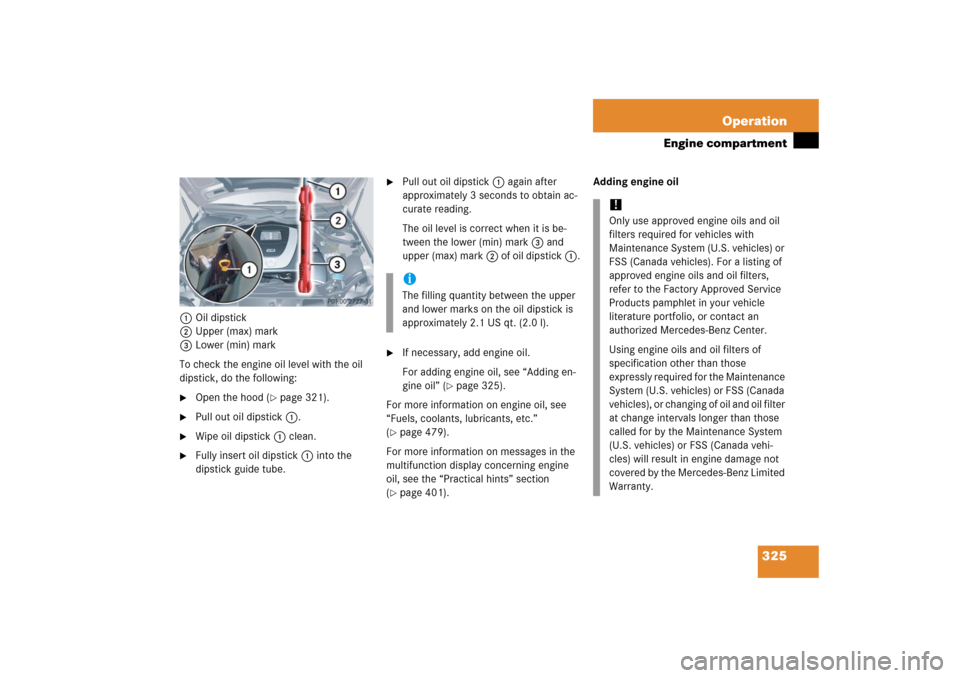Page 145 of 514

144 Controls in detailControl systemStandard display menu
In the standard display, the outside tem-
perature and the trip odometer are shown
in the multifunction display.1Outside temperature
2Trip odometer
If you see another display, press
buttonè orÿ repeatedly until the
standard display appears.
�
Press buttonk orjto select
the functions in the standard display
menu.
The following functions are available:Display digital speedometer
�
Press buttonj ork until the
digital speedometer appears in the
multifunction display.
The current vehicle speed is shown in
the multifunction display and the sta-
tus line appears.
1Digital Speedometer
2Status line with outside temperature
3Trip odometer
iThe headings used in the menus table
are designed to facilitate navigation
within the system and are not neces-
sarily identical to those shown in the
control system displays.
The first function displayed in each
menu will automatically show you
which part of the system you are in.iYou can have the digital speedometer
displayed instead of the outside tem-
perature in the standard display. You
can select the setting in the submenu Instr. cluster
via the function
Basic
display
(�page 152).
Function
Page
Run Flat Indicator
342
Call up digital speedometer
144
Call up maintenance service
display
362
Check engine oil level
323
iYou can have the digital speedometer
displayed instead of the outside tem-
perature in the status line. You can se-
lect the setting in the submenu
Instr.
cluster
via the function
Status line
display
(�page 152).
Page 148 of 514

147 Controls in detail
Control system
�
Press buttonè orÿ repeatedly
until the vehicle status message
memory appears in the multifunction
display.
If the vehicle status message memory
menu does not appear, then there are
no messages stored.Vehicle status messages have been
recorded
If conditions have occurred causing status
messages to be recorded, the number of
messages appears in the multifunction
display:
1Number of messages
�
Press buttonk orj.
The stored messages will now be
displayed in the order in which they
have occurred.
For malfunction and warning messag-
es, see “Vehicle status messages in the
multifunction display” (
�page 383).Should the vehicle’s system record any
conditions while driving, the number of
messages will reappear in the multifunc-
tion display when the SmartKey in the
starter switch is turned to position0 or
removed from the starter switch. With
KEYLESS-GO*, turn off the engine by
pressing the KEYLESS-GO* start/stop
button and open the driver’s door.
Warning!
G
Malfunction and warning messages are only
indicated for certain systems and are inten-
tionally not very detailed. The malfunction
and warning messages are simply a remind-
er with respect to the operation of certain
systems and do not replace the owner’s
and/or driver’s responsibility to maintain
the vehicle’s operating safety by having all
required maintenance and safety checks
performed on the vehicle and by bringing
the vehicle to an authorized Mercedes-Benz
Center to address the malfunction and
warning messages (
�page 383).
iThe vehicle status message memory
will be cleared when you switch on the
ignition(
�page 34). You will then only
see high-priority messages in the multi-
function display (
�page 383).
Page 306 of 514
305 Operation
The first 1 000 miles (1 500 km)
Driving instructions
At the gas station
Engine compartment
Tires and wheels
Winter driving
Maintenance
Vehicle care
Page 308 of 514

307 Operation
Driving instructions
�Driving instructions
Drive sensibly – save fuel
Fuel consumption, to a great extent, de-
pends on driving habits and operating con-
ditions.
To save fuel you should:�
Keep tires at the recommended tire
inflation pressures.
�
Remove unnecessary loads.
�
Allow engine to warm up under low
load use.
�
Avoid frequent acceleration and decel-
eration.
�
Have all maintenance work performed
at the intervals specified in the
Maintenance Booklet and as required
by the Maintenance System (U.S. vehi-
cles) or FSS (Canada vehicles). Contact
an authorized Mercedes-Benz Center.
Fuel consumption is also increased by
driving in cold weather, in stop-and-go
traffic, on short trips and in hilly area.
Drinking and driving
PedalsPower assistance
Warning!
G
Drinking and driving and/or taking drugs
and driving are very dangerous combina-
tions. Even a small amount of alcohol or
drugs can affect your reflexes, perceptions
and judgment.
The possibility of a serious or even fatal ac-
cident are greatly increased when you drink
or take drugs and drive.
Do not drink or take drugs and drive or allow
anyone to drive who has been drinking or
taking drugs.
Warning!
G
Keep driver’s foot area clear at all times. Ob-
jects stored in this area may impair pedal
movement.Warning!
G
With the engine not running, there is no
power assistance for the brake and steering
systems. In this case, it is important to keep
in mind that a considerably higher degree of
effort is necessary to brake and steer the ve-
hicle.
Page 317 of 514

316 OperationDriving instructionsCatalytic converter
Your Mercedes-Benz is equipped with
monolithic-type catalytic converters, an
important element in conjunction with the
oxygen sensors to achieve substantial con-
trol of the pollutants in the exhaust emis-
sions. Keep your vehicle in proper
operating condition by following our
recommended maintenance instructions
as outlined in your Maintenance Booklet.
Emission control
Certain systems of the engine serve to
keep the toxic components of the exhaust
gases within permissible limits required by
law.
These systems, of course, will function
properly only when maintained strictly ac-
cording to factory specifications. Any ad-
justments to the engine should therefore
be carried out only by qualified
Mercedes-Benz Center authorized techni-
cians.
Engine adjustments should not be altered
in any way. Moreover, the specified service
jobs must be carried out regularly accord-
ing to Mercedes-Benz servicing require-
ments. For details refer to the
Maintenance Booklet.
!To prevent damage to the catalytic
converters, only use premium unleaded
gasoline in this vehicle.
Any noticeable irregularities in engine
operation should be repaired promptly.
Otherwise, excessive unburned fuel
may reach the catalytic converter,
causing it to overheat and potentially
start a fire.
Warning!
G
As with any vehicle, do not idle, park or op-
erate this vehicle in areas where combusti-
ble materials such as grass, hay, or leaves
can come into contact with the hot exhaust
system, as these materials could be ignited
and cause a vehicle fire.
Page 326 of 514

325 Operation
Engine compartment
1Oil dipstick
2Upper (max) mark
3Lower (min) mark
To check the engine oil level with the oil
dipstick, do the following:�
Open the hood (
�page 321).
�
Pull out oil dipstick1.
�
Wipe oil dipstick1 clean.
�
Fully insert oil dipstick1 into the
dipstick guide tube.
�
Pull out oil dipstick1 again after
approximately 3 seconds to obtain ac-
curate reading.
The oil level is correct when it is be-
tween the lower (min) mark3 and
upper (max) mark2 of oil dipstick1.
�
If necessary, add engine oil.
For adding engine oil, see “Adding en-
gine oil” (
�page 325).
For more information on engine oil, see
“Fuels, coolants, lubricants, etc.”
(
�page 479).
For more information on messages in the
multifunction display concerning engine
oil, see the “Practical hints” section
(�page 401).Adding engine oiliThe filling quantity between the upper
and lower marks on the oil dipstick is
approximately 2.1 US qt. (2.0 l).
!Only use approved engine oils and oil
filters required for vehicles with
Maintenance System (U.S. vehicles) or
FSS (Canada vehicles). For a listing of
approved engine oils and oil filters,
refer to the Factory Approved Service
Products pamphlet in your vehicle
literature portfolio, or contact an
authorized Mercedes-Benz Center.
Using engine oils and oil filters of
specification other than those
expressly required for the Maintenance
System (U.S. vehicles) or FSS (Canada
vehicles), or changing of oil and oil filter
at change intervals longer than those
called for by the Maintenance System
(U.S. vehicles) or FSS (Canada vehi-
cles) will result in engine damage not
covered by the Mercedes-Benz Limited
Warranty.
Page 329 of 514

328 OperationEngine compartmentBattery
Your vehicle’s battery is located in the
engine compartment on the right-hand
side (
�page 453).
The battery should always be sufficiently
charged in order to achieve its rated
service life. Refer to Maintenance Booklet
for battery maintenance intervals.
If you use your vehicle mostly for
short-distance trips, you will need to have
the battery charge checked more
frequently.
When replacing the battery, always use
batteries approved by Mercedes-Benz.
If you do not intend to operate your vehicle
for an extended period of time, consult an
authorized Mercedes-Benz Center about
steps you need to observe.Batteries contain materials that can harm
the environment if disposed of improperly.
Recycling of batteries is the preferred
method of disposal. Many states require
sellers of batteries to accept old batteries
for recycling.
G
Observe all safety instructions
and precautions when handling
automotive batteries.
A
Risk of explosion.
D
Keep flames or sparks away
from battery. Do not smoke.
B
Battery acid is caustic. Do not
allow it to come into contact
with skin, eyes or clothing.
In case it does, immediately
flush affected area with clean
water and seek medical help if
necessary.
E
Wear eye protection.
C
Keep children away.
F
Follow the instructions in this
Operator's Manual.
Page 332 of 514

331 Operation
Tires and wheels
Tire care and maintenance
Regularly check your tire inflation pressure
at least once a month. For more informa-
tion on checking tire inflation pressure see
“Recommended tire inflation pressure”
(�page 339).Tire inspection
Every time you check your tire inflation
pressure, you should also inspect your
tires for the following:
�
excessive treadwear (
�page 332)
�
cord or fabric showing through the
tire’s rubber
�
bumps, bulges, cuts, cracks or splits in
the tread or side of the tire
Replace the tire if you find any of the above
conditions.
Make sure you also inspect the spare tire
periodically for condition and inflation.
Spare tires will age and become worn over
time even if never used, and thus should be
inspected and replaced when necessary.Life of tire
The service life of a tire is dependent upon
varying factors including but not limited to:
�
Driving style
�
Tire inflation pressure
�
Distance driven
Warning!
G
Regularly check the tires for damage. Dam-
aged tires can cause tire inflation pressure
loss. As a result, you could lose control of
your vehicle.
Worn, old tires can cause accidents. If the
tire tread is badly worn, or if the tires have
sustained damage, replace them.
Warning!
G
Tires and spare tire should be replaced after
six years, regardless of the remaining tread.